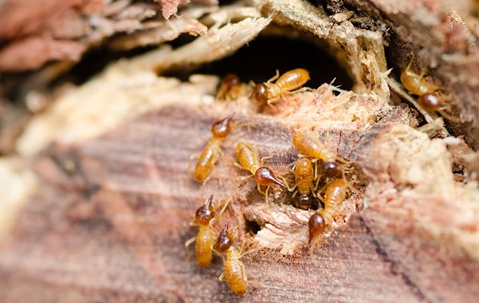It all began with a tiny hole in a dark corner of your living room. At first, you think it’s just a harmless crack in the paint. But as the days go by, that hole grows larger, revealing tiny tunnels that seem to lead nowhere. And then, the big reveal! You see swarms of small, pale insects scrambling around the edges of the hole, carrying bits of wood in their jaws. It’s termites! Your heart sinks to the bottom of your stomach as you realize one of the most notorious destroyers of homes and buildings is on your property. The battle has begun, and you know it won’t be an easy one to win.
But with Pro Active Pest Control on your side, there's no need to worry. We offer commercial and residential pest control, rodent control, bed bug control, and more! We put homeowners’ minds at ease by providing effective termite treatments and methods to get rid of these destructive critters before they can do any more harm. Read on to learn more about these chomping world champions and how professionals with Queen Creek pest control can get rid of them.
The Life Cycle Of A Termite Colony
The life cycle of a termite colony is complex and involves several different castes of termites, each with its own specific role in the colony's survival. There are:
- Reproductive termites, also known as swarmers or alates, leave their original colony to mate and start a new one at a different location. The female lays eggs that hatch into pale, tiny larvae.
- Worker termites care for the larvae, which molt several times before developing into nymphs.
- Nymphs get assigned a specific, lifetime role as either a soldier, worker, or swarmer, depending on the needs of the colony.
- Soldier termites guard the colony, workers gather food and watch over the young, and swarmers eventually leave the nest to start the life cycle process all over again.
To learn more about the habits and behaviors of termites, get in touch with your local termite and pest control company, Pro Active Pest Control. We can answer any questions you have or perform a property inspection if you suspect you have termites.
Unsubtle Signs Of Termite Damage
Since termites are highly destructive pests that can turn your wooden structures into a mountain of sawdust if you don’t stop them, the sooner you detect their existence, the better. One of the most common signs of termites in your home is the appearance of small holes or tunnels in wood, particularly near the exterior. Piles of sawdust may accompany these holes, which is a byproduct of the termites' tunneling and feeding activities.
You may also notice sagging or buckling floors, loose tiles or floorboards, and discarded wings. In addition to visible damage, your wood may start to sound hollow when tapped. Contact Pro Active Pest Control if you’ve observed any of these warning signs of a termite invasion.
Identify And Remove Factors That Attract Termites
Identifying a termite problem first is necessary to remove the elements that attract these insects. Start by eliminating sources of moisture since termites require a damp environment to survive. This means fixing leaky pipes, keeping gutters clean and free of debris, and making sure that the soil around the foundation of your home is sloped away from the structure to prevent water from pooling.
Another important factor to consider is wood-to-soil contact, as this can provide a direct pathway for termites to enter your home. Be sure to keep firewood, lumber, and other wood-based products stored away from the foundation of your home, and use non-wood alternatives whenever possible.
The Pros To Know For Total Termite Control In Queen Creek
Pro Active Pest Control is the go-to source for eradicating different kinds of termites to spare your home from costly damage. Since 2014, we have delivered impeccable home pest control service that our Queen Creek residents can trust!
Reach out to us today, so we can start working on your complimentary estimate. Our team is ready to help!

